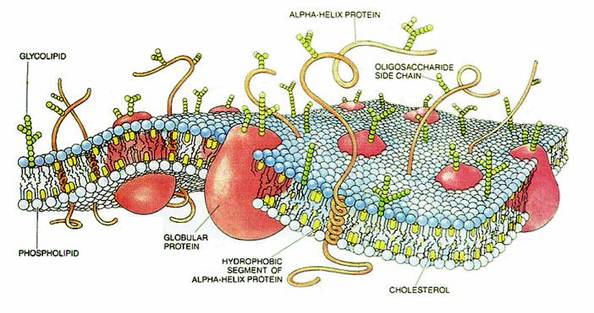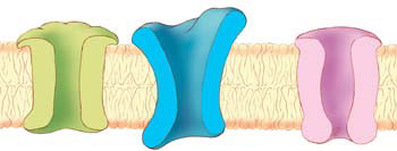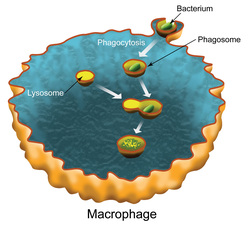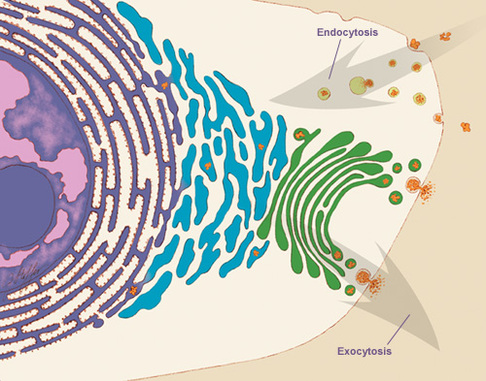Cell Membranes Structure Osmosis Permeabilty Transport Ideas

Cell Membrane, a Phospholipid-Protein Complex Cell Organelle. Credit: NCNR NIST
Membranes permit cells to be cells and to live and survive. The cell outer cell membrane or plamalemma is a complex and dynamic structure. The cell membrane surrounds and protects all the essential internal cell organelles and materials needed for life, growth and survival of the cell and it is the gateway through which atoms and molecules enter or exit a cell.
Cell Membranes – Diffusion, Osmosis, Passive and Active Transport
To understand the properties and abilities of a cell membrane let us define some important terms first.
Diffusion is the random movement of molecules from one location to another location. Diffusion is a random, unpredictabale process, i.e. we can never actially predict where a molecule will diffuse to. Diffusion has many types: solids can diffuse in liquids (e.g. ink particles or dirt in water). Liquids can diffuse in liquids (e.g. alcohol in water). And, finally, a gas can diffuse in another gas or liquid (e.g. perfume, deodorant or potpourri can diffuse in air.
Osmosis is diffusion of water across a selectively permeable membrane. Osmosis is one of the common and important events in all cells and it occurs all the time and during every second of a cell's existence.
Passive transport is a non-energy-requiring, protein-assisted, passage of a molecule across the membrane and into the cell.
Active transport is an energy-requiring, protein-assisted, movement of materials into, or out, of a cell. ATP, or GTP, are the major energy-storage compounds used for active transport.
Cell Active Transport by Endocytosis (Phagocytosis, Pinocytosis) and Exocytosis
When a cell is alive and working, energy is required and used in the process. Electricity energy makes a light bulb shine brightly and makes a microwave oven or coffee-maker work.The energy for active transport that drives all the cell's reactions is mainly ATP. ATP is produced by cells from sugar or similar compounds. The ATP is made during the process of glycolysis (sugar fermentation) in the cytoplasm and also ATP is made during the Kreb's cycle oxidative phosphorylation reactions that occur in the mitochondria. Plants produce energy by both these means, and plants also generate ATP during photosynthesis.
In summary, ATP is needed for active transport. Active transport includes:
How Outer Cell Membranes are Organized and Structured
Early in the history of biology several things were discovered about outer cell membranes.
Cell membranes:
Singer and Nicholson proposed the fluid mosaic model for cell membranes which is recognized as a useful and significant simple and trealistic illustration of a cell membrane. The fluid mosaic model shows a bilayer of lipid with immersed structural and transport proteins and enzyme proteins. This membrane model has led to many researches and experiments that have improved on the original model.
A closer look at this confirmed and updated cell membrane model indicates:
Specialized Membrane Features and Components
Chemical signals received at the cell membrane can move into the cell, and signals from within the cell can be transported to the membrane and released into the surrounding tissues.
Mammalian eukaryotic cells have 4 main receptors:
Cell Membranes – Diffusion, Osmosis, Passive and Active Transport
To understand the properties and abilities of a cell membrane let us define some important terms first.
Diffusion is the random movement of molecules from one location to another location. Diffusion is a random, unpredictabale process, i.e. we can never actially predict where a molecule will diffuse to. Diffusion has many types: solids can diffuse in liquids (e.g. ink particles or dirt in water). Liquids can diffuse in liquids (e.g. alcohol in water). And, finally, a gas can diffuse in another gas or liquid (e.g. perfume, deodorant or potpourri can diffuse in air.
Osmosis is diffusion of water across a selectively permeable membrane. Osmosis is one of the common and important events in all cells and it occurs all the time and during every second of a cell's existence.
Passive transport is a non-energy-requiring, protein-assisted, passage of a molecule across the membrane and into the cell.
Active transport is an energy-requiring, protein-assisted, movement of materials into, or out, of a cell. ATP, or GTP, are the major energy-storage compounds used for active transport.
Cell Active Transport by Endocytosis (Phagocytosis, Pinocytosis) and Exocytosis
When a cell is alive and working, energy is required and used in the process. Electricity energy makes a light bulb shine brightly and makes a microwave oven or coffee-maker work.The energy for active transport that drives all the cell's reactions is mainly ATP. ATP is produced by cells from sugar or similar compounds. The ATP is made during the process of glycolysis (sugar fermentation) in the cytoplasm and also ATP is made during the Kreb's cycle oxidative phosphorylation reactions that occur in the mitochondria. Plants produce energy by both these means, and plants also generate ATP during photosynthesis.
In summary, ATP is needed for active transport. Active transport includes:
- sodium-potassium pump (ionic pumping system) exchanges sodium inside the cell with potassium outside the cell. The Na+/K+ works like a bilge pump in a boat. Excess water is pumped out from the boat by a bilge pump. Excess sodium is pumped out of the cell by a transport protein pump. The sodium is pumped out and useful potassium is exchanged to the inside.
- phagocytosis is the ingestion of large cells such as bacteria, by macrophages or neutrophils.
- pinocytosis is the uptake of small micro-droplets or small molecular materials into the cell.
- exocytosis isthe reverse of endocytosis and involves the export of materials within vesicles to the membrane and then to the outside of the cell. Export of hormones, enzymes, and other materials is done by cells which make these materials for distribution via the bloodstream and lymphatics to other cells..
How Outer Cell Membranes are Organized and Structured
Early in the history of biology several things were discovered about outer cell membranes.
Cell membranes:
- are common to all animal and plant cells. Note: Plants also have cell walls of cellulose (paper or wood are cellulose compounds) surrounding their membranes. Paper and wood are products derived from plants.
- react with lipid, protein and sugar detection reagents. Therefore, cell membranes are lipoproteins that contain some sugars.
- are selectively or differentially permeable and, therefore, regulate molecular traffic into and out of the cell.
Singer and Nicholson proposed the fluid mosaic model for cell membranes which is recognized as a useful and significant simple and trealistic illustration of a cell membrane. The fluid mosaic model shows a bilayer of lipid with immersed structural and transport proteins and enzyme proteins. This membrane model has led to many researches and experiments that have improved on the original model.
A closer look at this confirmed and updated cell membrane model indicates:
- the lipid bilayer of the cell membrane is distinctive with lipid chains facing inward and phosphate groups facing to the outisde of the cell. This accounts for hydrophilic (water-loving) properties on the inner and outer surfaces, and the hydrophobic (water-fearing) lipid chains on the inside.
- proteins are immersed and embedded in many cell membrane locations. Some proteins form distinct cell channels for transport, other proteins are passive or active transport molecules that directly link to and process the ion or molecule to which they attach. Some proteins transport iron, copper, iron, other metals and still others are amino acid transporters. There are calcium channels and sodium-potassium pump channels.
- sugar and protein groups on the outer surface of the cell membrane define the cell types of different tissues and organs. These different surface chemical signatures define or characterize these cells. Different types of white blood cells (leukocytes) possess surface markers that distinguish them from one other. Red blood cells (erythrocytes) are defined by their sugar groups in the A, B and O blood group system. And liver, lung, heart, spleen, kidney, brain and other cells all have unique and special markers that make them unique from one another
Specialized Membrane Features and Components
Chemical signals received at the cell membrane can move into the cell, and signals from within the cell can be transported to the membrane and released into the surrounding tissues.
Mammalian eukaryotic cells have 4 main receptors:
- G-protein coupled receptors (GPCRs). There are many different types of G-protein receptors.
- Tyrosine-kinase linked receptors.
- Ion channel receptors.
- Intrinsic enzyme activity receptors.
This brief look at the cell membrane of eukaryotic cells indicates how something that seems so simple is really a complex, integrated and dynamic structure. Research uncovers and solves mysteries of membranes and proves membranes are truly amazing cell organelles.
This article is a revised and edited version of the original copyrighted article by the same author (DR) presented here.
Source
Lodish, H. et al. 2000. Molecular Cell Biology. Fourth Ed., W. H. Freeman and Co., New York, N.Y.
All the Written Material within Site is Copyrighted 2010 and Owned by Dr. Donald Reinhardt, and this original material is protected legally by this copyright notice and by the Digital Millennium Act. None of this original material may be copied or reproduced without the expressed written consent of the author. The author is a Freelance Science writer, and is available for specific assignments for those who are interested – by contacting adminstrator@sciencesuperchool.com. Other questions related to this teaching site should be directed to teacher@sciencesuperschool.com.


